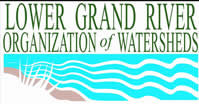Lower Grand Watershed Interactive Tool (WIT) - Organic Matter

Organic Matter
Organic Matter is residue from plant or animal origin (including leaves and grass clippings). In excessive amounts, organic matter can lower dissolved oxygen levels.
What is Organic Matter on Land?
In soil, organic matter consists of plant and animal material that is in the process of decomposing. When it is fully decomposed it is called humus. This humus is important for soil structure because it holds individual mineral particles together in clusters. Ideal soil has a granular, crumbly structure that allows water to drain through it, and allows oxygen and carbon dioxide to move freely between spaces with the soil and the air above. (1)
What is Organic Matter in Water?
Organic matter naturally enters water bodies when leaves fall, trees die and fall in, or when spring and falls heavy flows pull material in from the banks. In water, organic matter such as leaves and twigs make homes for macroinvetebrates (insects that live in water), which are the food sources for many fish species. The macroinvertebrates help to break down the leaves by tearing them and eating pieces. This helps the process of decomposition along. For decomposition of the remaining pieces of organic material to happen there needs to be bacteria present. Bacteria break down the matter and use oxygen to make their processes work.
Organic matter can enter waterways in unnatural forms as well. When grass clippings or leaves get into storm drains, they directly enter water bodies. Often these grass clippings and leaves are from plants that do not naturally occur in Michigan, therefore making it difficult for macroinvertebrates and bacteria to break them down. If pet waste is not properly disposed of, it too can be washed by stormwater into a water body.
So why is Organic Matter a Nonpoint Source Pollutant?
With an excessive amount of organic mater in a water body there will be a large amount of nutrients released into the water. "Any atom, ion, or molecule an organism needs to live, grow, or reproduce is called a nutrient. (such as carbon, oxygen, hydrogen, nitrogen, phosphorus, sulfur, potassium, calcium, magnesium, and iron), called macronutrients, are needed in a fairly larger amounts, whereas others (such as sodium, zinc, copper, chlorine, and iodine), called micronutrients, are needed in small or even trace amounts." (2)
The large amounts of nutrients will allow other photosynthesizing plants to grow, such as algae. This can be seen as algae blooms. When this unnatural amount of plant growth uses up the spike in nutrients they die. When they die the bacteria start decomposing the remaining organic matter. When they do this for this unnaturally large amount of material they deplete oxygen levels potentially harming aquatic wildlife.
Sources:
(1) Natural Resources Conservation Service Backyard Conservation Tip Sheet, "
Organic Matter in Soil"
(2) Miller, G. Tyler Jr. 2000. Living in the Environment 11th edition. Brooks/Cole Publishing Company. pg 86,87.
